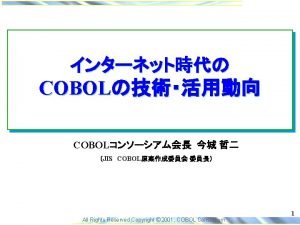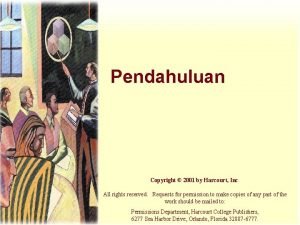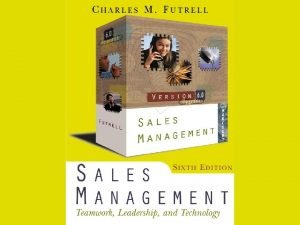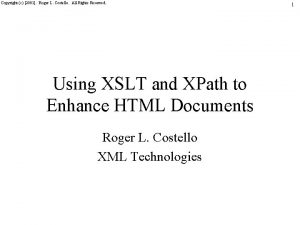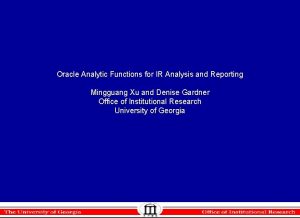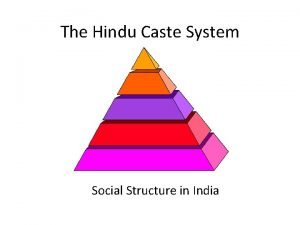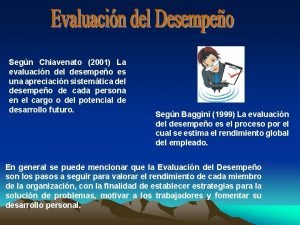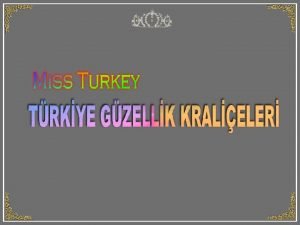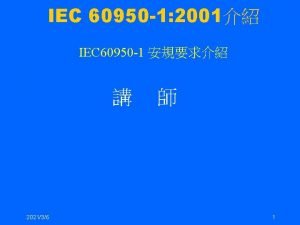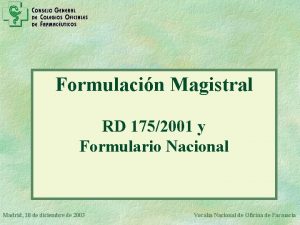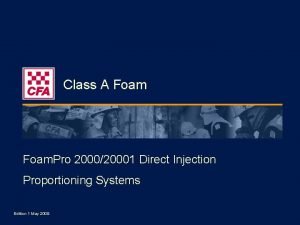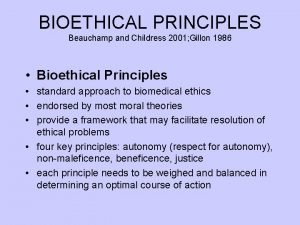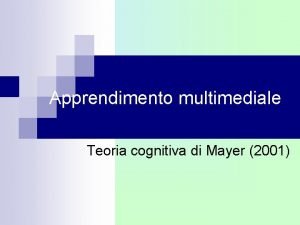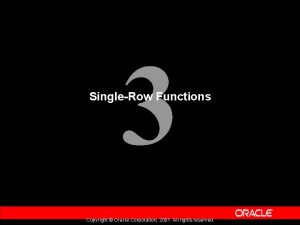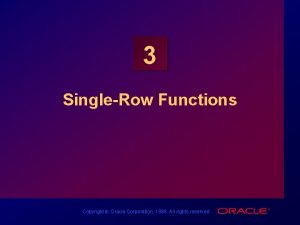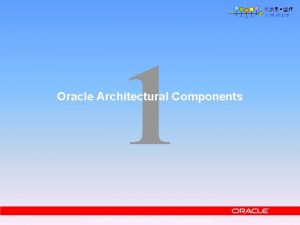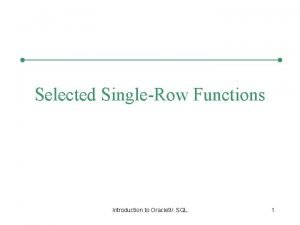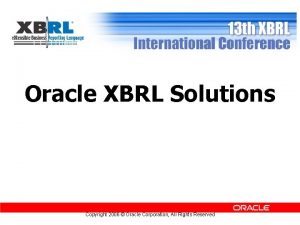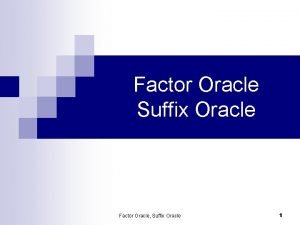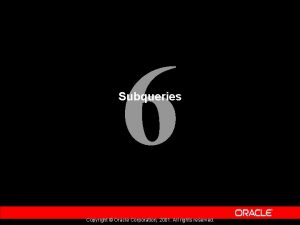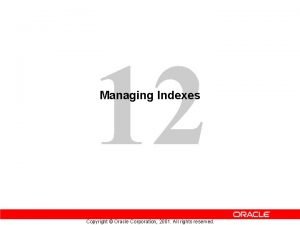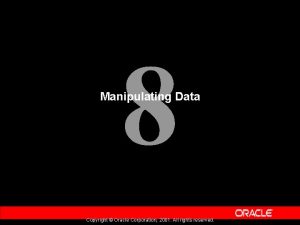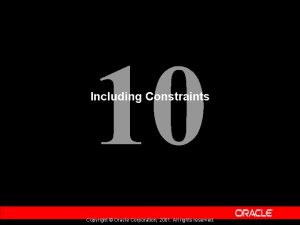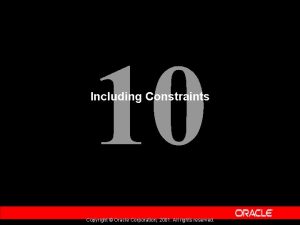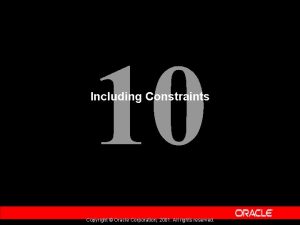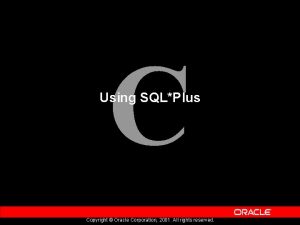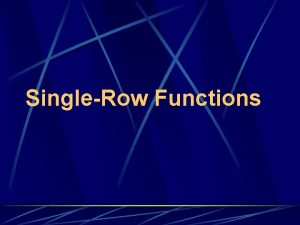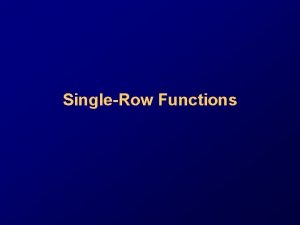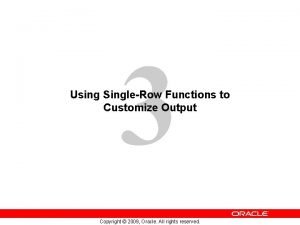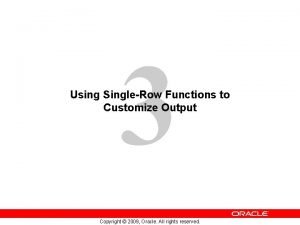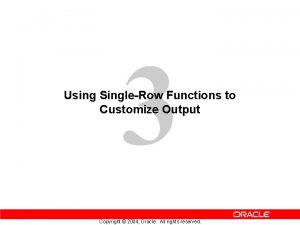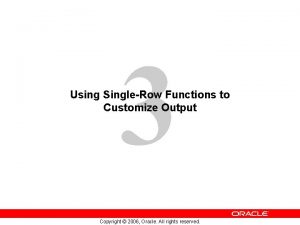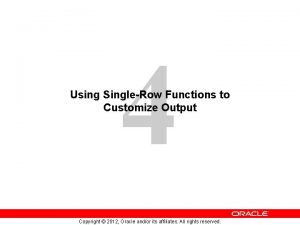3 SingleRow Functions Copyright Oracle Corporation 2001 All






































- Slides: 38

3 Single-Row Functions Copyright © Oracle Corporation, 2001. All rights reserved.

SQL Functions Input Function arg 1 Function performs action arg 2 Result value arg n 3 -2 Output Copyright © Oracle Corporation, 2001. All rights reserved.

Two Types of SQL Functions Single-row functions 3 -3 Multiple-row functions Copyright © Oracle Corporation, 2001. All rights reserved.

Single-Row Functions Single row functions: • • Manipulate data items Accept arguments and return one value Act on each row returned Return one result per row May modify the data type Can be nested Accept arguments which can be a column or an expression function_name [(arg 1, arg 2, . . . )] 3 -4 Copyright © Oracle Corporation, 2001. All rights reserved.

Single-Row Functions Character General Single-row functions Conversion 3 -5 Number Date Copyright © Oracle Corporation, 2001. All rights reserved.

Character Functions Character functions Case-manipulation functions LOWER UPPER INITCAP 3 -6 Character-manipulation functions CONCAT SUBSTR LENGTH INSTR LPAD | RPAD TRIM REPLACE Copyright © Oracle Corporation, 2001. All rights reserved.

Case Manipulation Functions These functions convert case for character strings. Function Result LOWER('SQL Course') sql course UPPER('SQL Course') SQL COURSE INITCAP('SQL Course') Sql Course 3 -7 Copyright © Oracle Corporation, 2001. All rights reserved.

Using Case Manipulation Functions Display the employee number, name, and department number for employee Higgins: SELECT employee_id, last_name, department_id FROM employees WHERE last_name = 'higgins'; no rows selected SELECT employee_id, last_name, department_id FROM employees WHERE LOWER(last_name) = 'higgins'; 3 -8 Copyright © Oracle Corporation, 2001. All rights reserved.

Character-Manipulation Functions These functions manipulate character strings: Function 3 -9 Result CONCAT('Hello', 'World') Hello. World SUBSTR('Hello. World', 1, 5) Hello LENGTH('Hello. World') 10 INSTR('Hello. World', 'W') 6 LPAD(salary, 10, '*') *****24000 RPAD(salary, 10, '*') 24000***** TRIM('H' FROM 'Hello. World') ello. World Copyright © Oracle Corporation, 2001. All rights reserved.

Using the Character-Manipulation Functions 1 SELECT employee_id, CONCAT(first_name, last_name) NAME, job_id, LENGTH (last_name), INSTR(last_name, 'a') "Contains 'a'? " FROM employees WHERE SUBSTR(job_id, 4) = 'REP'; 1 3 -10 2 Copyright © Oracle Corporation, 2001. All rights reserved. 3 2 3

Number Functions • ROUND: Rounds value to specified decimal ROUND(45. 926, 2) • TRUNC: Truncates value to specified decimal TRUNC(45. 926, 2) • 45. 92 MOD: Returns remainder of division MOD(1600, 300) 3 -11 45. 93 100 Copyright © Oracle Corporation, 2001. All rights reserved.

Using the ROUND Function 1 2 SELECT ROUND(45. 923, 2), ROUND(45. 923, 0), ROUND(45. 923, -1) FROM DUAL; 1 3 2 DUAL is a dummy table you can use to view results from functions and calculations. 3 -12 Copyright © Oracle Corporation, 2001. All rights reserved. 3

Using the TRUNC Function 1 SELECT FROM TRUNC(45. 923, 2), TRUNC(45. 923, -2) DUAL; 1 3 -13 2 2 Copyright © Oracle Corporation, 2001. All rights reserved. 3 3

Using the MOD Function Calculate the remainder of a salary after it is divided by 5000 for all employees whose job title is sales representative. SELECT last_name, salary, MOD(salary, 5000) FROM employees WHERE job_id = 'SA_REP'; 3 -14 Copyright © Oracle Corporation, 2001. All rights reserved.

Working with Dates • • Oracle database stores dates in an internal numeric format: century, year, month, day, hours, minutes, seconds. The default date display format is DD-MON-YY. SELECT last_name, hire_date FROM employees WHERE last_name like 'G%'; 3 -15 Copyright © Oracle Corporation, 2001. All rights reserved.

Working with Dates SYSDATE is a function that returns: • 3 -16 Date / Time Copyright © Oracle Corporation, 2001. All rights reserved.

Arithmetic with Dates 3 -17 • Add or subtract a number to or from a date for a resultant date value. • Subtract two dates to find the number of days between those dates. Copyright © Oracle Corporation, 2001. All rights reserved.

Using Arithmetic Operators with Dates SELECT last_name, (SYSDATE-hire_date)/7 AS WEEKS FROM employees WHERE department_id = 90; 3 -18 Copyright © Oracle Corporation, 2001. All rights reserved.

Date Functions 3 -19 Function Description MONTHS_BETWEEN Number of months between two dates ADD_MONTHS Add calendar months to date NEXT_DAY Next day of the date specified LAST_DAY Last day of the month ROUND Round date TRUNC Truncate date Copyright © Oracle Corporation, 2001. All rights reserved.

Using Date Functions • MONTHS_BETWEEN ('01 -SEP-95', '11 -JAN-94') 19. 6774194 • ADD_MONTHS ('11 -JAN-94', 6) '11 -JUL-94' • NEXT_DAY ('01 -SEP-95', 'FRIDAY') '08 -SEP-95' • LAST_DAY('01 -FEB-95') 3 -20 Copyright © Oracle Corporation, 2001. All rights reserved. '28 -FEB-95'

Using Date Functions Assume SYSDATE = '25 -JUL-95': 3 -21 • ROUND(SYSDATE, 'MONTH') 01 -AUG-95 • ROUND(SYSDATE , 'YEAR') 01 -JAN-96 • TRUNC(SYSDATE , 'MONTH') 01 -JUL-95 • TRUNC(SYSDATE , 'YEAR') 01 -JAN-95 Copyright © Oracle Corporation, 2001. All rights reserved.

Conversion Functions Data type conversion Implicit data type conversion 3 -22 Explicit data type conversion Copyright © Oracle Corporation, 2001. All rights reserved.

Explicit Data Type Conversion TO_NUMBER CHARACTER TO_CHAR 3 -23 TO_DATE TO_CHAR Copyright © Oracle Corporation, 2001. All rights reserved. DATE

Using the TO_CHAR Function with Dates TO_CHAR(date, 'format_model') The format model: 3 -24 • Must be enclosed in single quotation marks and is case sensitive • • Can include any valid date format element Has an fm element to remove padded blanks or suppress leading zeros • Is separated from the date value by a comma Copyright © Oracle Corporation, 2001. All rights reserved.

Elements of the Date Format Model YYYY Full year in numbers YEAR Year spelled out MM Two-digit value for month MONTH Full name of the month MON DY DAY DD 3 -25 Three-letter abbreviation of the month Three-letter abbreviation of the day of the week Full name of the day of the week Numeric day of the month Copyright © Oracle Corporation, 2001. All rights reserved.

Using the TO_CHAR Function with Dates SELECT last_name, TO_CHAR(hire_date, 'fm. DD Month YYYY') AS HIREDATE FROM employees; … 3 -26 Copyright © Oracle Corporation, 2001. All rights reserved.

Using the TO_CHAR Function with Numbers TO_CHAR(number, 'format_model') These are some of the format elements you can use with the TO_CHAR function to display a number value as a character: 3 -27 9 Represents a number 0 Forces a zero to be displayed $ Places a floating dollar sign L Uses the floating local currency symbol . Prints a decimal point , Prints a thousand indicator Copyright © Oracle Corporation, 2001. All rights reserved.

Using the TO_CHAR Function with Numbers SELECT TO_CHAR(salary, '$99, 999. 00') SALARY FROM employees WHERE last_name = 'Ernst'; 3 -28 Copyright © Oracle Corporation, 2001. All rights reserved.

RR Date Format Current Year 1995 2001 Specified Date 27 -OCT-95 27 -OCT-17 27 -OCT-95 RR Format 1995 2017 1995 YY Format 1995 1917 2095 If the specified two-digit year is: If two digits of the current year are: 3 -29 0– 49 50– 99 0– 49 The return date is in the current century 50– 99 The return date is in the century after the current one The return date is in the century before the current one The return date is in the current century Copyright © Oracle Corporation, 2001. All rights reserved.

Example of RR Date Format To find employees hired prior to 1990, use the RR format, which produces the same results whether the command is run in 1999 or now: SELECT last_name, TO_CHAR(hire_date, 'DD-Mon-YYYY') FROM employees WHERE hire_date < TO_DATE('01 -Jan-90', 'DD-Mon-RR'); 3 -30 Copyright © Oracle Corporation, 2001. All rights reserved.

Nesting Functions • • Single-row functions can be nested to any level. Nested functions are evaluated from deepest level to the least deep level. F 3(F 2(F 1(col, arg 1), arg 2), arg 3) Step 1 = Result 1 Step 2 = Result 2 Step 3 = Result 3 3 -31 Copyright © Oracle Corporation, 2001. All rights reserved.

Nesting Functions SELECT last_name, NVL(TO_CHAR(manager_id), 'No Manager') FROM employees WHERE manager_id IS NULL; 3 -32 Copyright © Oracle Corporation, 2001. All rights reserved.

General Functions These functions work with any data type and pertain to using nulls. • NVL (expr 1, expr 2) 3 -33 Copyright © Oracle Corporation, 2001. All rights reserved.

NVL Function Converts a null to an actual value. • Data types that can be used are date, character, and number. • Data types must match: – NVL(commission_pct, 0) – NVL(hire_date, '01 -JAN-97') – NVL(job_id, 'No Job Yet') 3 -34 Copyright © Oracle Corporation, 2001. All rights reserved.

Using the NVL Function 1 SELECT last_name, salary, NVL(commission_pct, 0), (salary*12) + (salary*12*NVL(commission_pct, 0)) AN_SAL FROM employees; … 1 3 -35 Copyright © Oracle Corporation, 2001. All rights reserved. 2 2

Conditional Expressions • Provide the use of IF-THEN-ELSE logic within a SQL statement • Use two methods: – DECODE function 3 -36 Copyright © Oracle Corporation, 2001. All rights reserved.

The DECODE Function Facilitates conditional inquiries by doing the work of an IF-THEN-ELSE statement: DECODE(col|expression, search 1, result 1 [, search 2, result 2, . . . , ] [, default]) 3 -37 Copyright © Oracle Corporation, 2001. All rights reserved.

Using the DECODE Function SELECT last_name, job_id, salary, DECODE(job_id, 'IT_PROG', 1. 10*salary, 'ST_CLERK', 1. 15*salary, 'SA_REP', 1. 20*salary, salary) REVISED_SALARY FROM employees; … … 3 -38 Copyright © Oracle Corporation, 2001. All rights reserved.
 Copyright 2001
Copyright 2001 Copyright 2001
Copyright 2001 Copyright 2001
Copyright 2001 Copyright (c) 2001-
Copyright (c) 2001- Copyright 2001
Copyright 2001 Copyright 2001
Copyright 2001 Name three line segments
Name three line segments Microsoft corporation. all rights reserved.
Microsoft corporation. all rights reserved. Microsoft corporation. all rights reserved.
Microsoft corporation. all rights reserved. Microsoft corporation. all rights reserved.
Microsoft corporation. all rights reserved. Microsoft corporation. all rights reserved
Microsoft corporation. all rights reserved Copyright 2015 all rights reserved
Copyright 2015 all rights reserved Copyright © 2015 all rights reserved
Copyright © 2015 all rights reserved Dell all rights reserved copyright 2009
Dell all rights reserved copyright 2009 Copyright © 2018 all rights reserved
Copyright © 2018 all rights reserved Oracle analytics functions
Oracle analytics functions 2001: a space odyssey the sentinel
2001: a space odyssey the sentinel Oregon trail platforms
Oregon trail platforms India most powerful caste
India most powerful caste Lateralization
Lateralization Stuff that happened in 2001
Stuff that happened in 2001 Chiavenato 2001
Chiavenato 2001 Só doi quando eu respiro. porto alegre l&pm 2001
Só doi quando eu respiro. porto alegre l&pm 2001 Mehr qolur sheri
Mehr qolur sheri Pınar özdemir miss turkey
Pınar özdemir miss turkey Kasus manajemen laba
Kasus manajemen laba Iloosh
Iloosh Iec 60950
Iec 60950 Real decreto 175 de 2001
Real decreto 175 de 2001 Gothenburg riots 2001
Gothenburg riots 2001 Nom 010 tur 2001
Nom 010 tur 2001 Foampro 2001
Foampro 2001 Beauchamp and childress 2001
Beauchamp and childress 2001 Mayer 2001
Mayer 2001 Ang pagbasa ay isang psycholinguistic game.
Ang pagbasa ay isang psycholinguistic game. Xxxxxx 2008
Xxxxxx 2008 Helilooja 1949-2001
Helilooja 1949-2001 Destination imagination 2001
Destination imagination 2001 Http //sciencespot.net
Http //sciencespot.net
